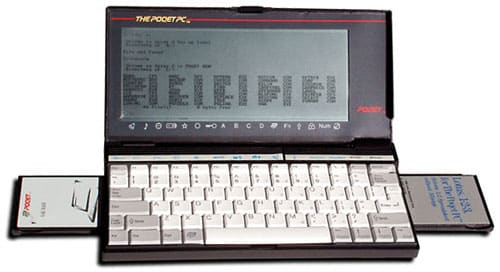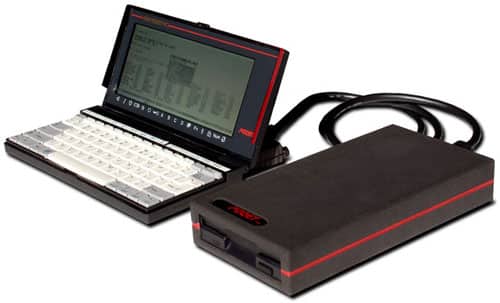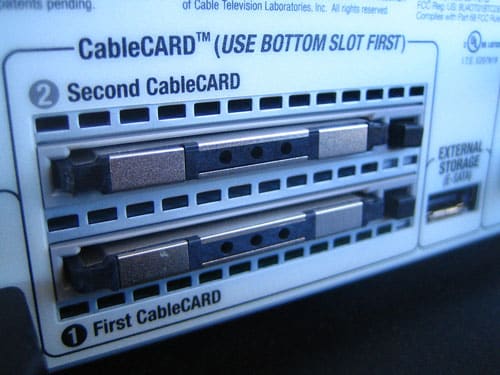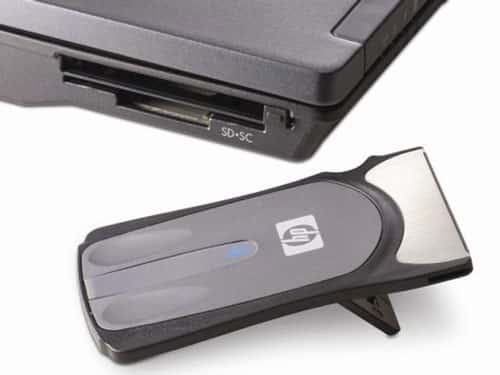It’s All In The Cards
With PCMCIA (also known as PC Card), it was easy to upgrade our old laptops. But for years, the tech was relegated to a depressing bureaucratic fate.
Hey all, today’s issue is a refresh of a 2017 Tedium issue that has a pretty significant update to highlight, caught by my pal Matthew Keys, who runs a great media and tech blog called The Desk. More on that in a moment.
Fight the background noise … and win. If you’re stuck at home trying to do video calls with lots of background distractions, a little AI could help drown those noises out. Check out the AI tool Krisp, which does just that. It’s one of Ernie’s favorite programs, and it has a free version.
“The devices may be as slim as credit cards, but the name is about as easy to read as a credit report. Happily, this may be the last time you need to say the acronym, PCMCIA.”
— A blurb from Popular Science, circa 1995, discussing the name change of PCMCIA to the easier-to-explain PC Card. (We’re using PCMCIA in every reference, just to be contrarian.) The confusing acronym, which stands for Personal Computer Memory Card International Association but which once earned the mocking nickname “People Can’t Memorize Computer Industry Acronyms,” was also changed for another reason, according to Computerworld: the port wasn’t just about memory anymore, but about a wide variety of peripherals, such as modems.

The Poqet PC, which actually predates the PCMCIA standard. (via Old-Computers.net)
The PCMCIA standard came about due to a need for flash memory in a tiny computer
In 1989, a computer that weighed just a pound and could fit inside a pocket was a big deal.
Portability, at this time, was not a virtue of computers. In September of 1989, Apple released its first portable Macintosh, a device that weighed 16 pounds and relied on lead-acid batteries, just like Power Wheels.
We’ve come a long way from that whole mess, and the key turning point may have been thanks to a company called Poqet Computer Company, which released a tiny DOS-based computer not long after Apple released its ill-fated Macintosh Portable. The Poqet PC, an XT-style clone with a DOS-based interface, tackled the problem of portability from the opposite direction as Apple—it went for a tiny scale, a scale too small for even a floppy drive, which would zap energy and add a lot of mechanical parts.
To make up for that, the company researched whether it’d be possible to use memory cards in its place. Problem was, most of the standards were bad, so they needed to create one.
Fortunately, they found a kindred spirit on the issue in Fujitsu, which felt that its memory-storage format had a lot of potential for PC-makers. Sensing the need, Fujitsu and Poqet eventually set the foundation for a standards organization in September of 1989. Soon, dozens of other companies were interested in hopping on board.
There was already some work on this front from the Japanese Electronics Industry Development Association, which had begun working on a memory card standardization scheme in 1985. PCMCIA initially borrowed JEIDA’s 68-pin connector setup, and over time the two groups worked together and their standards became functionally compatible.

The massive external disk drive for the Poqet PC needed twice as many AA batteries as the main device. (via Old-Computers.net)
The official PCMCIA standard came out in 1990, and the Poqet PC was first to the market with a compatible platform. The tiny laptop actually predates PCMCIA by a few months, and beyond that, the device offered a pretty nifty benefit: The tiny computer could work for months on just a couple of AA batteries. No lead acid here.
(Fujitsu soon swooped up the company.)
Befitting an agreed-upon standard, PCMCIA eventually morphed into a wide array of uses.
In 1994, for example, SanDisk designed the CompactFlash memory card, which is based on PCMCIA—effectively, it’s a smaller version of the memory cards that the Poqet and its successors used. The main difference between PCMCIA and CompactFlash beyond size, in fact, is that CompactFlash has 50 pins instead of 68.
The platform ultimately became best known allowing laptops to have built-in modems, wireless cards, and other communication devices—something allowed after an update to the PCMCIA spec in 1991.
But beyond sheer storage and communication, there was a period in which it was assumed by some industry observers that PCMCIA would take over as the standard upgrade platform not just for laptops, but for PCs as a whole. In a 1993 article for PC Magazine, Winn Rosch envisioned a time when “you may even find a PC Card lurking in your toaster oven or your music synthesizer.”
Part of the reason was the versatility of the design. Putting a Sound Blaster in a 486 wasn’t hard, but it required a more technical hand than most PC owners were used to. The PCMCIA format, with its standardized design and foolproof installation process (just plug it into the slot!), made adding a hard drive into a machine something a mere mortal could do.
That said, it turned out that Rosch was only half-right. Technology eventually did come built into many of the normal devices we use on a daily basis, but it wasn’t the PCMCIA card; it was USB. (It wasn’t involved in any toasters, however, except for sheer novelty reasons.)
Look at this freaking thing! It’s a mouse that fits in a PCMCIA slot! Isn’t this insane?!
Five interesting uses of the PCMCIA platform over the years
- Voice dictation tools: In the ’90s, IBM experimented with a hardware and software solution, Voicetype Dictation, that allows users to dictate commands to their computer. While this came in a standard ISA-style card for PCs, they also created a version of this for PCMCIA slots, according to The New York Times.
- Memory expansion for Mercedes-Benz vehicles: Some models of Mercedes-Benz have PCMCIA slots, which sounds bizarre, but also has some major benefits, because it means that such devices theoretically support numerous kinds of flash memory for their drive consoles, particularly CompactFlash. Here’s a video (in Spanish) of the card reader in use.
- Physical storage: After the PCMCIA standard gave way to the newer ExpressCard standard, some company came out with a device called the StashCard, which is basically a physical compartment for holding things—like pieces of paper you’re too lazy to dictate to your computer with your Voicetype Dictation card.
- Remote controls: Also in the same subgenere of “uses for the slot now that it’s obsolete,” SlashGear pointed out in 2008 the existence of a device called the Outel USB Media Remote, which hid a computer remote control in the PCMCIA slot.
- A friggin’ external mouse: Trying to carry a mouse along with your laptop can be a total pain in the butt, but Hewlett-Packard decided it’d be awesome to solve that problem by creating an extremely-thin mouse that fit in a PCMCIA slot and could charge inside the device when not in use. JUST LOOK AT THIS THING. IT IS A REAL PRODUCT.

Devices like TiVo often require multiple CableCard slots to record shows. CableCard is based on PCMCIA. (spine/Flickr)
How PCMCIA maintained a threadbare modern foothold on the cable industry
As awesomely weird as that PCMCIA mouse is, it doesn’t rank as the weirdest use of the PCMCIA standard.
That honor goes to CableCARD, an effort by the Federal Communications Commission to force the cable industry to let customers use third-party boxes for their cable systems. For nearly two decades, the cable industry had to use PCMCIA cards for completely bureaucratic reasons.
At first, there was an air of excitement around this device. In a 2004 article on the phenomenon, which was just getting off the ground, New York Times writer David Pogue noted that the card, which stores subscriber information and the ability to descramble pictures, was “a bit of circuitry miniaturization that’s about 15 years overdue.”
But it was a complicated road to get to the card, as might be expected, considering the fact that this is the federal government we’re talking about. For one thing, CableCARD entered the market just as PCMCIA was being replaced with the ExpressCard in PCs. And while CableCARDs could be installed in some televisions, the functionality was hobbled at launch, as it only supported one-way communication, meaning you could get standard cable channels, but not video on demand.
The cable industry spent years dragging its feet on the CableCARD, which was bad news for TiVo, the tech company whose entire business model was reliant on customer access to these CableCARDs.
“Over the years we have heard that some consumers have issues breaking through these barriers when all they want to do is enjoy the very best TV experience through TiVo,” the company stated in 2010, as the FCC implemented new rules pushing cable companies to take the CableCARD rules seriously.
It was just one of many headaches around this stupid card. (In 2007, Pogue wrote another article reminding folks that he wrote with excitement about the CableCARD in 2004, only to see the bubble basically burst due to industry inaction.)
So we have this technology which is already based on an old standard, is sort of hobbled, and the cable industry doesn’t really like it.
Which explains why, in 2020, the FCC has finally decided to change course. As reported by Matthew Keys last week, the FCC decided to remove the longstanding requirement that required cable providers to offer CableCARDs to consumers. Had the approach built marketshare, it would have made sense. But in reality, TiVo was kind of out on its own with the CableCARD for much of its history. While there were smaller players like SiloconDust’s HDHomeRun, TiVo was the only one close to mainstream.
“Consumer demand for retail CableCARD devices never developed as anticipated and such demand has declined steadily in recent years due to the growing popularity of [streaming services],” the FCC commissioners said in a statement.
It was perhaps a long time coming: The saga of the CableCARD nearly ended during the Obama administration, but only got picked up once again near the end of Trump’s first (and possibly only) term. The PCMCIA’s lone mainstream use case lingered for years without much of an update.
A bit of a shame in the saga is that the result will allow cable companies to do the bare minimum for those who want an alternative experience to the set-top box. While the FCC will require a software alternative to the descrambling hardware, the software alternative can be the cable company’s own streaming service. Which means the cable company won this battle.
That’s a fitting end for a device that Wired once eloquently called “a technological annoyance beyond many people’s willingness to endure.”
It’s a sad irony that the PCMCIA slot, which in many ways was designed to make our laptop computers upgradeable without a whole lot of headaches, has largely gone the way of the lead-acid battery as a peripheral for our computing devices.
Even the ExpressCard slots, which were fairly common for a time, have largely faded from most modern laptops. No Macbook model has supported the expansion card format since 2012, and while some PCs still support them, they haven’t been too common for a few years now.
Heck, the group formerly known as PCMCIA doesn’t exist anymore—it was usurped by the USB Implementers Forum in 2010. Guess we don’t care about expansion devices on laptops anymore.
But despite all that, in a weird way, the credit-card-sized form factor of the PCMCIA slot is making a bit of a comeback. And it’s thanks to the very kind of community that found value in the upgradeability use case of the card slot oh-so-many years ago.
Back in 2016, a project called EOMA68 got off the ground with a campaign on CrowdSupply, raising $235,250. The conceit of the campaign was this: It’s an open-source computer, complete with diagrams and the whole nine yards, that is portable, can fit in pretty much any casing you give it, and is … wait for it … the exact size of a classic PCMCIA card.
Why this specific size and build? Easy: Because PCMCIA cases are really tough.
“If you put a devboard into your pocket, it’s going to get destroyed very very quickly,” creators Luke Kenneth Casson Leighton and Christopher Waid wrote on the CrowdSupply page. “This is why we picked legacy PCMCIA because you get a robust metal case.”
Of course, the initiative also reflects many of the challenges of crowdsourcing. Despite the fact that I originally wrote about this nearly four years ago, it still hasn’t shipped to customers.
“Apologies to people who keep asking “when will I receive my shipment?’,” one such comment states. “The answer has to be, ‘when all the unknown and unknowable issues have been investigated and eliminated, one at a time.’ This is just how it is.”
In a weird way, once they do finally ship, these devices will fulfill the mission of PCMCIA. However, they invert the equation, so that you’re not replacing the parts around the computer, but the brains of the computer itself, in a way that keeps the user in control.
Now just imagine if the cable industry worked like that. Oh wait.
--
Find this one an interesting read? Share it with a pal! Thanks to Krisp for sponsoring, and Matthew Keys for the tipoff that led to tonight’s refresh.
:format(jpeg)/2017/06/tedium012617.gif)
/2017/06/tedium012617.gif)



/uploads/ernie_crop.jpg)